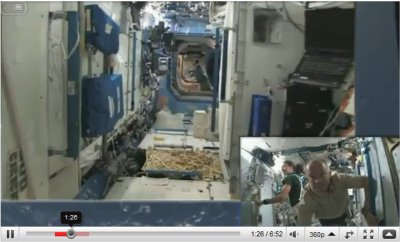An HD Video Tour of the International Space Station is simple walkthrough of this incredible project and all its corners. This video tour of the International Space Station is an interesting video, but is has also some annoying things on it. It sometimes overuses picture in picture and superimposed images effects in the video. Just because something can be done with a video, doesn’t mean it should be done.

57 Comments
Tomi Engdahl says:
Object that slammed into Florida home was indeed space junk from ISS, NASA confirms
News
By Mike Wall
published April 16, 2024
It was part of a pallet jettisoned along with 5,800 pounds of aging batteries back in March 2021.
https://www.space.com/object-crash-florida-home-iss-space-junk-nasa-confirms
Tomi Engdahl says:
Astronauts Stranded With No Set Return Date For New Boeing Starliner
https://www.sciencealert.com/astronauts-stranded-with-no-set-return-date-for-new-boeing-starliner
After helium leaks and thruster problems with Boeing’s Starliner capsule, NASA has been pushing back the return date from the International Space Station.
On Friday, the agency announced they no longer had a planned return date. Instead, they will keep testing the capsule, trying to understand its issues, and seeing if they can make any fixes. Plenty of supplies are on the station, so there’s no urgent need to bring the two astronauts back to Earth.
Tomi Engdahl says:
https://www.iflscience.com/nasa-begins-plans-to-crash-the-international-space-station-into-the-ocean-74842?fbclid=IwZXh0bgNhZW0CMTEAAR2O6wK_XgOyFwtL53zbkCyxK8bW4D_s0Bac6b4WLAE36E2YTK3mHfLq9-E_aem_AO5GdOtmBoTr7EyYJEmEcg
All good things must come to an end, and NASA is now planning for the demise of humanity’s orbiting laboratory. The American space agency announced on Wednesday that it has selected SpaceX to develop and build the Deorbit Vehicle that will be used to deorbit the space station at the end of its operational life, bringing it safely down to Earth.
Tomi Engdahl says:
It’s Official: NASA Will Rescue Its Stranded Astronauts With SpaceX, Not Boeing’s Plagued Starliner
https://futurism.com/the-byte/nasa-dumps-boeing-starliner-spacex
Tomi Engdahl says:
Boeing Might Not Get Starliner Working Before the Space Station Is Destroyed
https://futurism.com/the-byte/boeing-starliner-working-before-space-station-destroyed
Boeing could quickly run out of time.
Clock Ticking
Over the weekend, NASA officially decided that it was too risky to return its two stranded astronauts Sunita Williams and Butch Wilmore on board Boeing’s plagued Starliner.
The decision came as a massive blow to Boeing. After many years of development, the company still doesn’t have a successful crewed test flight under its belt.
And whether the much-maligned capsule will ever be able to deliver and safely return a crew to and from the International Space Station remains an open question.
That’s because NASA is already planning to decommission the orbital outpost in 2030 with SpaceX’s help, giving Boeing roughly five years to get its act together — and it’s already been around five years since the company’s failed uncrewed test flight.
Harrison told NPR that he thinks it’s “fairly likely” that Boeing may choose to “step back” from Starliner “within a few weeks or months.”
“This program kind of sticks out as something that doesn’t fit with the rest of their business,” he added.
Boeing has already lost a staggering $1.6 billion on the development of Starliner. That’s on top of getting more than $4 billion worth of funding through NASA’s Commercial Crew Program in 2014.
Meanwhile, SpaceX has done far more with far less funding from the space agency, having completed just shy of a dozen crewed missions to the ISS.
One way to look at the situation is that NASA would have been out of luck if it weren’t for the fact that it signed up both SpaceX and Boeing to develop spacecraft.
“If they had only selected one provider, it would have been Boeing, because SpaceX was the risky prospect at the time,”
Tomi Engdahl says:
https://arstechnica.com/space/2024/09/starliners-speaker-began-emitting-strange-sonar-noises-on-saturday/?fbclid=IwY2xjawFCc1NleHRuA2FlbQIxMQABHQYtlcyPwOoz-nEYwWkKms_92-OHG4bIGXWPSysq-joz_PBnU2qcPNGwxA_aem_3Vuh5Bf5QJQIACrOm6WHpg
Tomi Engdahl says:
Boeing Reportedly Looking to Sell Off Its Disastrous Starliner Spacecraft
https://futurism.com/the-byte/boeing-sell-off-starliner
Embattled aerospace giant Boeing is reportedly looking to sell off its space business following the disastrous crewed test launch of its much-maligned Starliner that left two NASA astronauts stranded in space.
As the Wall Street Journal reports, insider sources claim that Boeing is looking to get out of the space race altogether in the face of a deepening financial crisis — a startling about-face for a company that’s worked on iconic space vehicles ranging from NASA’s Space Shuttle to the International Space Station.
Despite a decade of development, Boeing has yet to successfully deliver and return astronauts on board its Starliner capsule, a damning indictment of a company that already has several major fires to put out.
In other words, it shouldn’t come as a surprise that Boeing is looking to cut its losses — but buyer beware.